Class 6: Mathematics
-
Chapter 1: Knowing Our Numbers5 Topics|2 Quizzes
-
Session 1: International Number System and Indian Number System - Definition, Chart, Interactives and Examples
-
Session 2: Comparing and Ordering Numbers - Steps and Examples
-
Session 3: Estimation of Numbers (Rounding Off Method) - Rules, Steps and Examples
-
Session 4: Roman Numerals - Definition, Rules, Chart, Conversion and Examples
-
NCERT Flip Book (Chapter 1: Knowing Our Numbers)
-
Session 1: International Number System and Indian Number System - Definition, Chart, Interactives and Examples
-
Chapter 2: Whole Numbers5 Topics
-
Session 1: What are Whole Numbers? - Definition, Symbol, Comparison and Examples
-
Session 2: Addition and Subtraction of Whole Numbers - Properties and Examples
-
Session 3: Multiplication and Division of Whole Numbers - Division Algorithm, Properties and Examples
-
Session 4: Patterns in Whole Numbers - Definition, Types and Examples
-
NCERT Flip Book (Chapter 2: Whole Numbers)
-
Session 1: What are Whole Numbers? - Definition, Symbol, Comparison and Examples
-
Chapter 3: Playing With Numbers8 Topics
-
Session 1: What is a Factor? - Properties, Methods, Interactives and Examples
-
Session 2: What is a Multiple? - Definition, Properties, Interactives and Examples
-
Session 3: Prime Numbers and Composite Numbers - Sieve of Eratosthenes, Definition, List, Facts and Examples
-
Session 4: Prime Factorisation - Definition, Methods, Steps and Examples
-
Session 5: Divisibility Rules for 2, 3, 4, 5, 6, 8, 9, 10 and 11 - Properties, Chart and Examples
-
Session 6: Highest Common Factor (H.C.F.) - Definition, Methods, Steps, Interactives and Examples
-
Session 7: Lowest Common Multiple (L.C.M.) - Definition, Methods, Steps, Interactives and Examples
-
NCERT Flip Book (Chapter 3: Playing With Numbers)
-
Session 1: What is a Factor? - Properties, Methods, Interactives and Examples
-
Chapter 4: Integers5 Topics
-
Session 1: What are Integers? - Definition, Symbol, Number line, Absolute Value and Examples
-
Session 2: Comparing and Ordering Integers - Rules and Examples
-
Session 3: Addition of Integers - Steps, Rules, Number Line, Interactives and Examples
-
Session 4: Subtraction of Integers - Steps, Rules, Properties, Number Line, Interactives and Examples
-
NCERT Flip Book (Chapter 4: Integers)
-
Session 1: What are Integers? - Definition, Symbol, Number line, Absolute Value and Examples
-
Chapter 5: Fractions6 Topics
-
Session 1: What are Fractions? - Definition, Representation, Number line, Interactives and Examples
-
Session 2: Types of Fractions - Definition, Interactives and Examples
-
Session 3: Comparing and Ordering Fractions - Methods, Interactives and Examples
-
Session 4: Adding Fractions (Like and Unlike Denominators) - Steps, Interactives and Examples
-
Session 5: Subtracting Fractions - (Like and Unlike Denominators) - Steps, Interactives and Examples
-
NCERT Flip Book (Chapter 5: Fractions)
-
Session 1: What are Fractions? - Definition, Representation, Number line, Interactives and Examples
-
Chapter 6: Decimals11 Topics
-
Session 1: What are Decimals? - Definition, Place Value Chart, Expansion, Types, Conversion and Interactives
-
Session 2: Decimal Fraction - Definition, Types, Conversion, Steps, Interactive and Examples
-
Session 3: Comparing Decimals - Steps, Interactive and Examples
-
Session 4: Uses of Decimal Notation - Conversion Chart and Examples
-
Session 5: Adding Decimals - Steps, Interactive and Examples
-
Session 6: Subtracting Decimals - Steps, Interactive and Examples
-
Session 7: Length Conversion - Metric Units and Customary Units
-
Session 8: Mass (Weight) Conversion - Metric Units and Customary Units
-
Session 9: Capacity Conversion - Metric Units and Customary Units
-
Session 10: Temperature Conversion - Metric Units and Customary Units
-
NCERT Flip Book (Chapter 6: Decimals)
-
Session 1: What are Decimals? - Definition, Place Value Chart, Expansion, Types, Conversion and Interactives
-
Chapter 7: Algebra3 Topics
-
Chapter 8: Ratio, Proportion and Unitary Method3 Topics
-
Chapter 9: Understanding Elementary Shapes2 Topics
-
Chapter 10: Basic Geometrical Ideas7 Topics
-
Session 1: What is Geometry? - Points, Lines, Planes and Solids
-
Session 2: Angles - Definition, Types, Interactives and Examples
-
Session 3: Polygons and Curves - Definition, Types, Interactives and Examples
-
Session 4: Triangles - Definition, Types, Interactives and Examples
-
Session 5: Quadrilaterals - Definition, Types, Properties, Interactives and Examples
-
Session 6: Circles - Definition, Formulae, Interactives and Examples
-
Session 7: What are Parallel Lines? - Transversal, Properties, Angles, Interactives and Examples
-
Session 1: What is Geometry? - Points, Lines, Planes and Solids
-
Chapter 11: Mensuration8 Topics
-
Session 1: Perimeter of Rectangle - Formula, Definition, Interactive and Examples
-
Session 2: Perimeter of Square - Formula, Definition, Interactive and Examples
-
Session 3: Perimeter of Triangle - Formula, Definition, Interactives and Examples
-
Session 4: Area of Rectangle - Formula, Definition, Interactive and Examples
-
Session 5: Area of Square - Formula, Definition, Interactives and Examples
-
Session 6: Area of Triangle - Formula, Definition, Interactives and Examples
-
Session 7: Area of Composite Shapes - Definition, Formula, Interactives and Examples
-
Session 8: Area of Irregular Shapes Using Squared Paper - Definition, Interactives and Examples
-
Session 1: Perimeter of Rectangle - Formula, Definition, Interactive and Examples
-
Chapter 12: Symmetry2 Topics
-
Chapter 13: Data Handling3 Topics
-
Chapter 14: Practical Geometry5 Topics
-
Session 1: Construction of Line Segments - Methods, Steps and Interactives
-
Session 2: Construction of Perpendicular Lines (Perpendicular Bisector) - Steps and Interactives
-
Session 3: Construction of Circles - Steps, Interactives and Examples
-
Session 4: Construction of Angles - Steps and Interactives
-
Session 5: Construction of Some Standard Angles (30°, 45°, 60°, 90°, 120° and 135°) - Steps and Examples
-
Session 1: Construction of Line Segments - Methods, Steps and Interactives
-
NCERT AND EXEMPLAR
Number System1 Topic -
Geometry1 Topic
-
Integers1 Topic
-
Fractions & Decimals1 Topic
-
Data Handling1 Topic
-
Mensuration1 Topic
-
Algebra1 Topic
-
Ratio & Proportion1 Topic
-
Symmetry & Practical Geometry1 Topic
Revolutionary SSC Bot: Unleashing Unmatched Efficiency and Precision
The SSC Bot is an advanced artificial intelligence-powered assistant designed to serve as a comprehensive guide for customers. It utilizes cutting-edge AI technology and natural language processing capabilities to understand and respond to customer queries effectively. With personalized assistance, 24/7 availability, and multilingual support, the SSC Bot ensures a seamless and efficient interaction for customers. It also possesses an extensive knowledge base, assists in troubleshooting and issue resolution, and seamlessly integrates with various platforms.
₹100.00Original price was: ₹100.00.₹49.00Current price is: ₹49.00.
Session 6: Area of Triangle – Formula, Definition, Interactives and Examples
Admin 17/11/2024
Area of Triangle
For finding the area of a triangle you need to identify the base and the height. The base of a triangle is generally considered the bottom of a shape; however, the shape might not always be oriented such that the base is on the bottom. The height of a triangle is the distance from the base to the opposite vertex at a right angle. The height of a triangle is also known as the altitude.
Formula for Area of Triangle
You can think of any triangle as half a parallelogram. If you rotate a triangle 180∘about the midpoint of one of its sides, the original triangle and the new triangle will be a parallelogram.
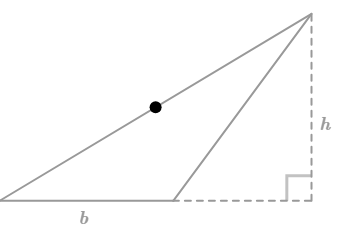
Therefore, the area of a triangle is base times height divided by two.
Remember that any of the three sides can be the base. Also, remember that the height must be perpendicular to the base and extend to the highest point of the triangle.
Areatriangle=\(\frac{bh}{2}\)=\(\frac{1}{2}\)bℎ
Perimetertriangle=Sum of three sides
Formula for Area of Right Angled Triangle
Perimeter=a+b+c
Area=\(\frac{1}{2}\)ab
Formula for Area of Equilateral Triangle
Perimeter=3a
Altitude=![]()
Area=
Formula for Area of Isosceles Triangle
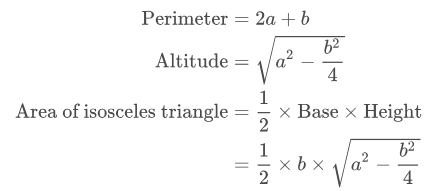
Area of Triangle – Examples
Example 1
Find the area of a right-angled triangle with a base of 6 cm and a height of 4 cm.
We know,
Area of right-angled triangle=\(\frac{1}{2}\)× base× height
=\(\frac{1}{2}\)×6×4
=12 cm2
Example 2
Find the area of an equilateral triangle with sides of 8 cm.
We know,
Area of an equilateral triangle with sides 
Area of an equilateral triangle with sides 

Example 3
Find the area of an isosceles triangle with equal sides of length of 17 cm and unequal sides of length of 30 cm.
We know,
For an isosceles triangle with equal sides of length a and unequal side of length b,
Area
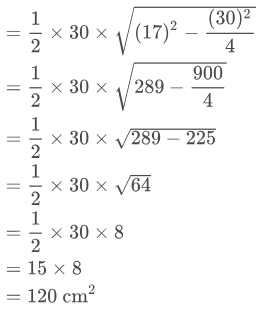
Example 4
Find the length of the side of an equilateral triangle having an area 576\(\sqrt{3}\) cm2.
We know,
For an equilateral triangle with equal sides of length a,
Area=
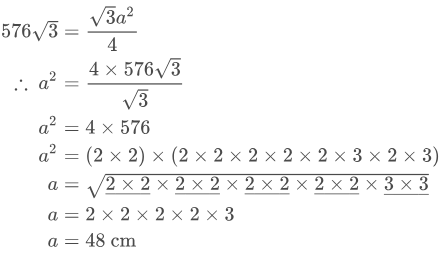
Example 5
Find the length of the equal sides of an isosceles triangle whose area is 420 cm2 and the unequal side (base) measures 40 cm.
We know,
For an isosceles triangle with equal sides of length a and unequal side of length b,
Area=
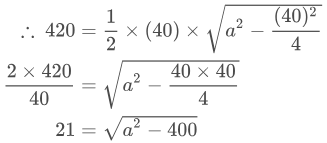
Squaring both sides, we get
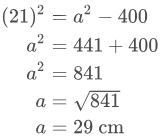
Example 6
Find the base of a triangle whose height is 30 cm and area is 750 cm2.
We know,
Area of triangle =\(\frac{1}{2}\)× base×height
750=\(\frac{1}{2}\)×base×(30)
base=\(\frac{750×2}{30}\)
base=25×2
base=50 cm
Example 7
Find the area of the △PQR, whose base PR is 7 cm and altitude QS is 6 cm. If the length of the base PQ is 14 cm, then find the length of the altitude RT.
Area of ![]()
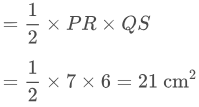
Also, area of the 

Example 8
The base of a triangular field is one-third its height. If the cost of cultivating the field at ₹845 per hectare is ₹11407.50, find its base and height.
The total cost of cultivating the field₹=₹11407.50.
Rate of cultivation₹=₹845/ hectare.
∴ Area of the field=\(\frac{cost}{rate}\)=\(\frac{11407.50}{845}\)
=13.5 hectare
=13.5×10000 (∵1 hectare=10000 m2)
=135000 m2
Let the base of the field be x meters.
Then, its height=3x meters.
∴ Area of the field=\(\frac{1}{2}\)×bℎ

∴ Base =x=300 m and height=3x=3(300)=900 m.











